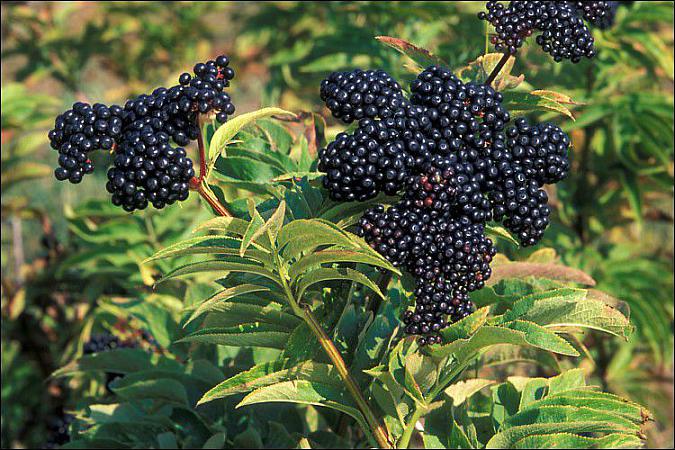Elderberry is a perennial shrub belonging to the Adoxaceae family.
It is also called:
- wild elderberry;
- elderberry is stinky.
Description
This shrub grows as a weed in wastelands, the sides of country roads, and forest edges. Sometimes there are dense thickets of elderberry in deciduous forests. It is easily accepted on sandy and clay soils, and also grows along the banks of rivers and small streams. It is found in the mountains (not higher than the middle zone) and forest-steppe of Europe, in the southern regions of Russia, in the low mountains of Central Asia, in Belarus and Ukraine.
This weed reaches a height of 1.5 m. The appearance of wild elderberry resembles black elderberry, but there is also a distinctive feature. During the flowering period, the herbaceous elderberry has not yellow, but red anthers. Its flowers form thyroid inflorescences. The stem is straight, the core is white. The plant has a powerful rhizome. The drupes are dark, the flesh is red and has an unpleasant aroma. The berries ripen in early September.
Everyone knows the myth of how Prometheus, belonging to the ancient Greek pantheon of deities, gave fire to humanity. And he placed the flame precisely in the empty elderberry trunk. According to legend, this tree was planted by evil spirits, which settled at the foot of the plant. The Slavs avoided unnecessary contact with this bush. Other peoples decorated clothes with elderberry branches on Walpurgis Night (to protect themselves from evil spirits). In biblical legends, there are several parables related to elderberries. In ancient times, its flowers were collected, which were amulets against vampires even before the use of garlic.
Compound
The berries are rich in tannins, organic acids and essential oils. They also contain sambucyanine (a dye) and amygdalin (a toxic alkaloid substance). For the preparation of potions, elderberry rhizome is mainly used, which contains tannins, saponins and bitterness. The composition of flowers has much in common with the composition of fruits.
When consuming fresh aerial parts of the plant, poisoning may occur due to the fact that amygdalin is converted into hydrocyanic acid. This dangerous alkaloid is neutralized by drying.
Medicinal properties
As mentioned above, elderberry herbaceous folk remedies most often contain its root. It contains active substances that cause the anti-inflammatory and strong diuretic effect of products prepared from it. Elderberry is also used as a laxative. The plant can lower blood sugar levels, so it is often used to combat diabetes. Research has shown that elderberry also has antitumor properties.
Medicinal use
In folk medicine, elderberry has gained fame due to its active biological substances. Diuretic drugs are made from the rhizome of the plant, which are then used for inflammation of the bladder and nephritis (kidney inflammation). They interact effectively with traditional medicines. Such drugs are used for dropsy of the abdominal and cardiac areas. Poultices and compresses are made from the herbal part of elderberry, which are used to treat various skin diseases (rashes, diaper rash). The flower infusion is an excellent diaphoretic and astringent. It is also used as a mouth rinse.

According to some reports, wild elderberry can treat cancer. Today there are some homeopathic anti-cancer drugs that contain this plant. However, official medicine has not yet confirmed such properties.
Leaves and flowers must be used with extreme caution, as they contain a toxic alkaloid. It is necessary to strictly monitor the dosage. And the berries of the plant have not found their use in folk medicine at all due to their excessive toxicity, so children should not be allowed near the bush.
Recipes
Antitumor decoction:
For one tablespoon of dried, finely chopped rhizomes, take 0.5 liters of water and put on fire. After the broth has boiled, it is left on low heat for a quarter of an hour. Leave for 10-12 hours. Drink half an hour before meals, 50 ml per dose.
Infusion for dropsy:
Prepared dry chopped roots (30 g) are poured with a liter of boiled water. Leave for 2-3 hours and strain. Take a glass three times a day. This is an excellent diuretic.
Remedy for diabetes:
Place two teaspoons of rhizomes in a vessel, add two glasses of boiled water and leave for 3-4 hours. Drink up to five times a day, 2 tbsp. spoons.
Contraindications
The main danger in using this plant is overdose. In this case
Possible failure of the heart, kidneys or liver. Nausea and vomiting may begin. Elderberry is not recommended for pregnant women, nursing mothers, or young children.


